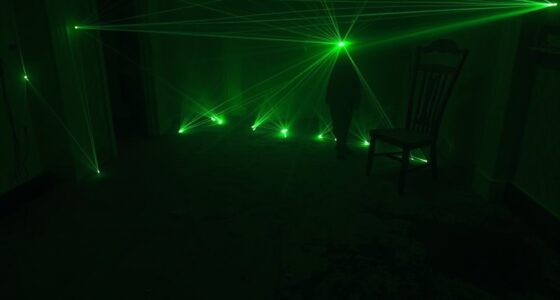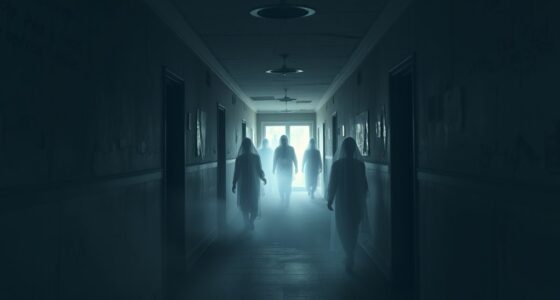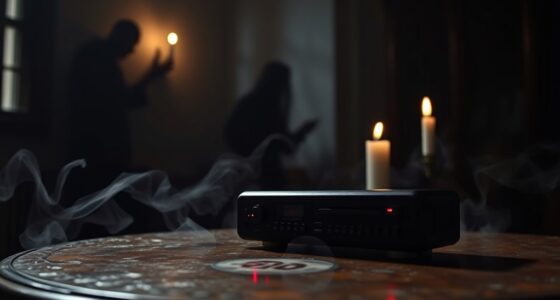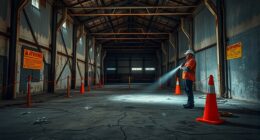Thermal imaging helps you detect heat signatures that may indicate paranormal activity by revealing temperature variations unseen to the naked eye. You might observe residual heat patterns or moving anomalies that suggest recent or ongoing presence. Proper calibration and environmental control are essential to avoid false positives. If you want to understand what these unusual heat spots mean and how to interpret them, there’s much more to discover beyond the surface.
Key Takeaways
- Ghostly heat signatures often appear as unusual, localized temperature anomalies that differ from natural environmental patterns.
- Residual heat patterns can indicate past activity, while moving signatures suggest ongoing supernatural presence.
- Proper thermal calibration and environmental controls are essential to accurately detect and interpret ghost-related heat signatures.
- Anomalous heat signatures that persist or deviate from natural causes may point to paranormal activity.
- Cross-referencing thermal data with other investigative methods helps distinguish genuine ghost signatures from environmental or natural factors.
How Thermal Imaging Works in Paranormal Detection
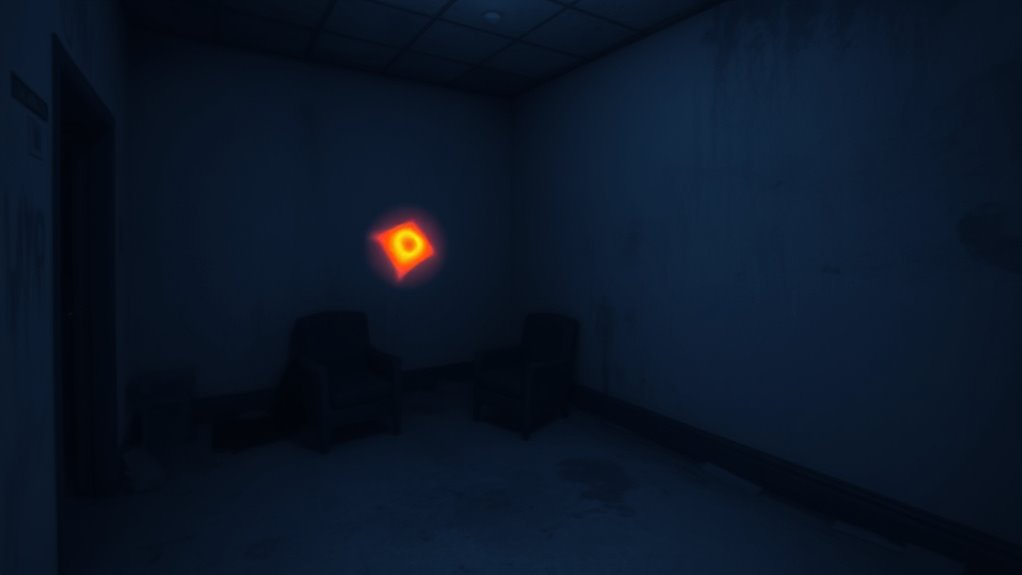
Thermal imaging plays a crucial role in paranormal detection by revealing temperature variations that might indicate the presence of spirits or other phenomena. To guarantee accurate readings, proper thermal calibration is essential; it adjusts the camera to account for environmental factors and improves sensitivity. When scanning a location, you set specific temperature thresholds to identify unusual heat signatures that stand out from the background. These thresholds help you distinguish between normal temperature fluctuations and potential paranormal activity. As the camera detects differences in thermal emissions, it creates a visual map of heat patterns. This allows you to observe anomalies in real-time, which could suggest something unusual is occurring. Correct calibration and well-defined thresholds are critical for reliable interpretation of thermal data during investigations. Additionally, understanding thermal signatures can aid in differentiating between natural and potentially paranormal anomalies. Recognizing environmental factors that influence temperature readings further enhances the accuracy of interpretations during investigations. Proper understanding of air circulation and heat sources is also vital, as they can significantly affect thermal readings and lead to false positives. Incorporating knowledge of thermal conductivity can help in analyzing the heat transfer characteristics of different materials and improve the identification of genuine anomalies. Furthermore, understanding sensor limitations ensures that investigators can better interpret the thermal data and avoid misreading natural variations as paranormal activity.
Types of Heat Signatures Observed in Investigations
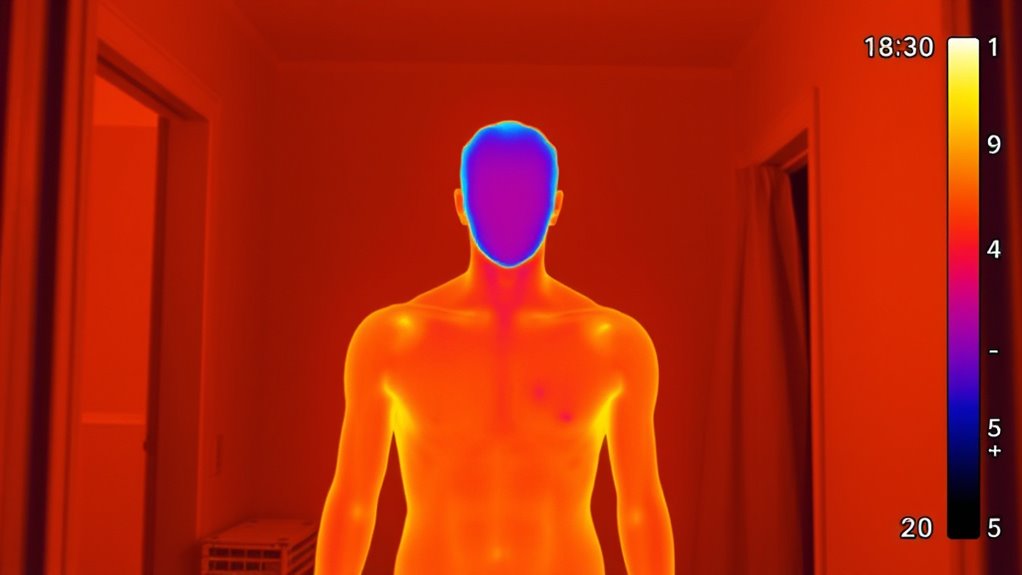
When using thermal imaging, you’ll notice different types of heat signatures that can reveal valuable clues. Residual heat patterns indicate past activity, while moving heat signatures suggest ongoing movement. Additionally, anomalous temperature fluctuations can point to unusual sources or hidden activity. For example, understanding color accuracy in thermal imaging can help differentiate between natural and unnatural heat sources. Recognizing heat signature patterns can also assist investigators in identifying specific behaviors or presence over time. Furthermore, interpreting these signatures requires knowledge of thermal resolution, which affects the clarity and detail of the heat images captured. The ability to analyze thermal contrast enhances the differentiation of subtle temperature differences, aiding in more precise investigations. An understanding of alimony laws can also be useful in investigative contexts involving legal proceedings, as financial details often play a role in such cases.
Residual Heat Patterns
Have you ever noticed how residual heat patterns can reveal essential details long after an event? These patterns arise from thermal residue, the lingering heat left behind after an activity or incident. When heat dissipates, it creates distinct signatures on surfaces, highlighting areas where heat was concentrated. Investigators use thermal imaging to detect these patterns, which can indicate recent movements, contact points, or even concealed objects. Residual heat often appears as uneven patches, fading over time but still providing valuable clues. By analyzing these patterns, you can determine the sequence of events or identify locations that experienced recent activity. Recognizing residual heat patterns allows you to piece together important details, even when the initial heat source is no longer present.
Moving Heat Signatures
Moving heat signatures provide dynamic insights that residual patterns alone can’t reveal. They are essential for refining hunting strategies and tracking elusive entities. When investigating suspected paranormal activity, observing shifting heat patterns can indicate recent movement or presence. These signatures often resemble ghostly footprints, where the heat trail shows a path or specific spots of activity. By monitoring how heat signatures change over time, you can distinguish between natural causes and potential supernatural sources. Moving heat signatures help you identify areas where activity is ongoing, rather than static. This real-time detection allows you to focus your efforts more precisely. Recognizing these dynamic patterns enhances your ability to differentiate genuine paranormal activity from environmental factors, making your investigations more efficient and accurate. Additionally, understanding the thermal properties of different surfaces can improve interpretation of the heat signatures and their implications during investigations. Recognizing the movement patterns of heat signatures can also aid in predicting where activity might occur next, optimizing investigation efforts.
Anomalous Temperature Fluctuations
Anomalous temperature fluctuations are key indicators in investigations, revealing heat signatures that deviate from natural or expected patterns. These fluctuations can be sudden, localized, or inconsistent, suggesting influences beyond normal thermal behavior. Sometimes, you might observe temperature anomalies linked to quantum entanglement, where correlated particles create unexpected heat patterns across distances. Electromagnetic interference can also cause irregular temperature shifts, affecting thermal readings and creating false positives. Recognizing these anomalies requires careful analysis to distinguish genuine paranormal activity from environmental factors. Understanding quantum effects and electromagnetic interference enhances your ability to interpret anomalous temperature fluctuations accurately during investigations. By focusing on these unusual heat signatures, you can identify subtle clues that point to hidden phenomena.
Equipment and Techniques for Capturing Ghostly Temperatures
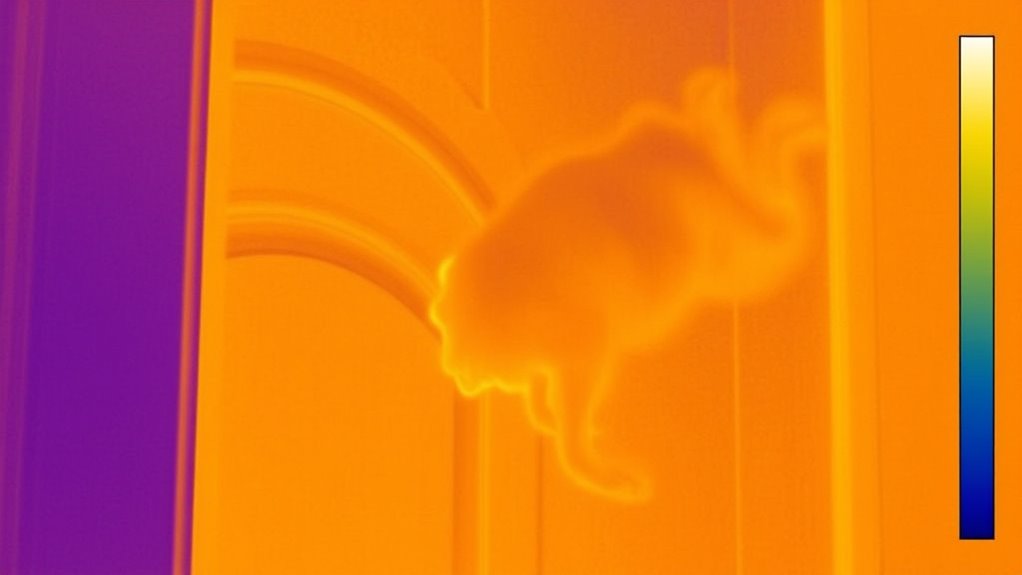
To effectively capture ghostly temperatures, you need to select the right infrared camera designed for investigative work. You’ll also want to guarantee the environment is suitable, as temperature readings can be affected by external conditions. Additionally, understanding thermal anomalies helps you distinguish genuine phenomena from misleading artifacts. Incorporating knowledge of data privacy concerns can also be crucial when sharing sensitive investigation data securely. Utilizing professional-grade equipment ensures higher accuracy and reliability during your investigations.
Selecting Suitable Infrared Cameras
Choosing the right infrared camera is essential for effectively capturing ghostly temperatures in investigations. You need a device with high infrared resolution to detect subtle thermal differences and reliable thermal calibration for accuracy. Look for cameras that offer adjustable thermal settings to refine your focus on specific areas. Consider the sensitivity of the sensor, which impacts the camera’s ability to distinguish tiny temperature variations. A well-calibrated camera ensures your readings are precise, reducing false positives. Here’s a quick visual guide:
| Feature | Importance |
|---|---|
| Infrared resolution | Detects fine temperature differences for ghost detection |
| Thermal calibration | Ensures accuracy in readings |
| Sensitivity | Highlights subtle thermal anomalies |
| Adjustability | Allows precise focus on problem areas |
Optimal Environmental Conditions
Selecting the right infrared camera sets the foundation for capturing ghostly temperatures, but ideal results also depend heavily on environmental conditions. Ambient humidity plays a vital role because high moisture levels can distort thermal readings, reducing accuracy. To mitigate this, choose times when humidity is low or confirm your camera is properly calibrated for the environment. Regular calibration is essential to maintain measurement precision, especially in fluctuating conditions. Additionally, minimize airflow and avoid direct contact with surfaces that could create temperature variations. Control lighting and background conditions as much as possible, since sudden temperature changes can obscure subtle thermal anomalies. By paying close attention to ambient humidity and confirming proper camera calibration, you enhance your chances of capturing clear, reliable thermal signatures during investigations.
Interpreting Thermal Anomalies
Interpreting thermal anomalies requires a keen eye and the right equipment to distinguish genuine ghostly signatures from false readings. You must be aware of thermal camouflage, where objects or surfaces hide heat signatures, making anomalies harder to identify. Heat diffusion can cause temperature changes that mimic paranormal activity, so understanding how heat spreads helps you differentiate natural variations from supernatural ones. Use high-quality thermal imaging devices that can detect subtle temperature differences and minimize false positives. Look for consistent patterns or sudden anomalies that defy heat diffusion principles. Remember, false readings often result from environmental factors or equipment limitations, so cross-check your data with environmental conditions. Developing this skill improves your ability to interpret thermal signatures accurately, advancing your investigation of ghostly phenomena.
Interpreting Anomalies: What Do Unexpected Heat Spots Mean?
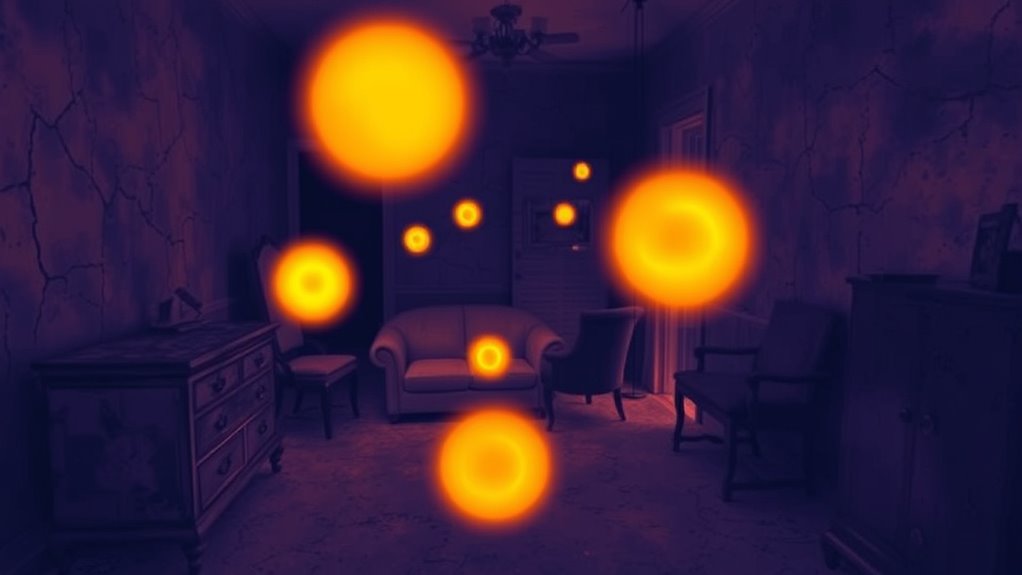
Unexpected heat spots in thermal images often signal something unusual that warrants closer inspection. These anomalies might indicate disturbances in energy fields or the presence of spirit residuals lingering in the area. When you see unexpected warmth, consider whether it aligns with natural causes like drafts or recent activity, or if it could be linked to residual energy from past events. Such heat signatures may suggest that an area retains a ghostly imprint, reflecting emotional or energetic echoes. Interpreting these anomalies requires careful analysis; not every heat spot is paranormal. However, persistent or unexplained heat signatures, especially near known activity zones, could point toward residual energy or spirit presence. Always corroborate thermal data with other investigative methods before drawing conclusions.
Challenges and Limitations of Thermal Imaging in Spirit Hunting
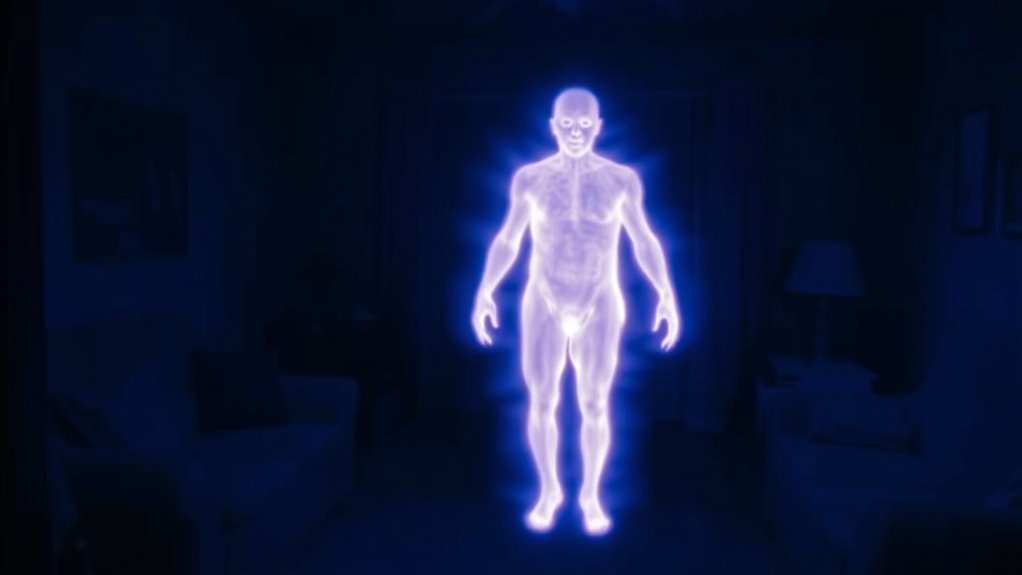
While thermal imaging can be a valuable tool in spirit hunting, it comes with notable challenges and limitations that can hinder your investigations. One major issue is camera calibration; if your thermal camera isn’t properly calibrated, it may produce inaccurate readings, leading you to chase false leads. Environmental factors such as drafts, sunlight, or nearby heat sources can cause false positives, making it harder to distinguish genuine anomalies from natural phenomena. Additionally, thermal cameras often have limited resolution, which can obscure subtle heat signatures. These limitations mean you need to interpret thermal data carefully and avoid jumping to conclusions based solely on thermal images. Recognizing these challenges helps you approach investigations with a critical eye, ensuring you don’t mistake everyday heat sources for paranormal activity.
Case Studies: Notable Investigations Using Thermal Cameras
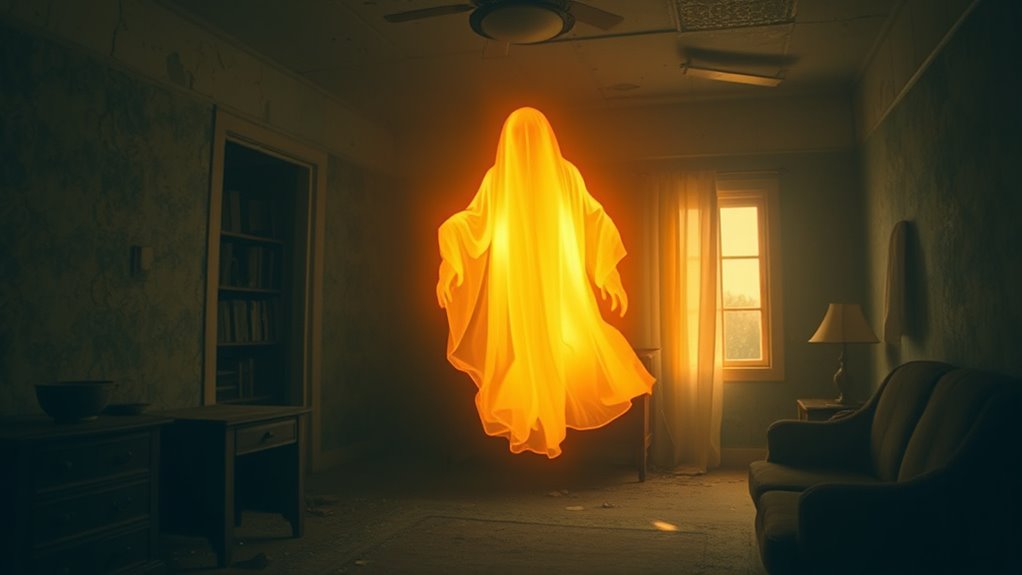
Thermal cameras have played a pivotal role in several high-profile investigations into paranormal activity. Historically, these devices gained attention during early ghost hunts, offering a new way to detect unexplained heat signatures. Cultural interpretations influence how these findings are viewed; some see thermal anomalies as evidence of spirits, while others attribute them to environmental factors. Notable cases include the Brown Lady of Raynham Hall, where thermal imaging captured mysterious warmth near the staircase, fueling debates about supernatural presence. In the Eastern traditions, similar thermal phenomena are linked to spiritual energy or ancestral spirits. These investigations demonstrate how thermal imaging, combined with cultural beliefs and historical context, shapes our understanding of paranormal encounters, making them compelling yet subject to interpretation.
Future Developments in Thermal Technology for Paranormal Research
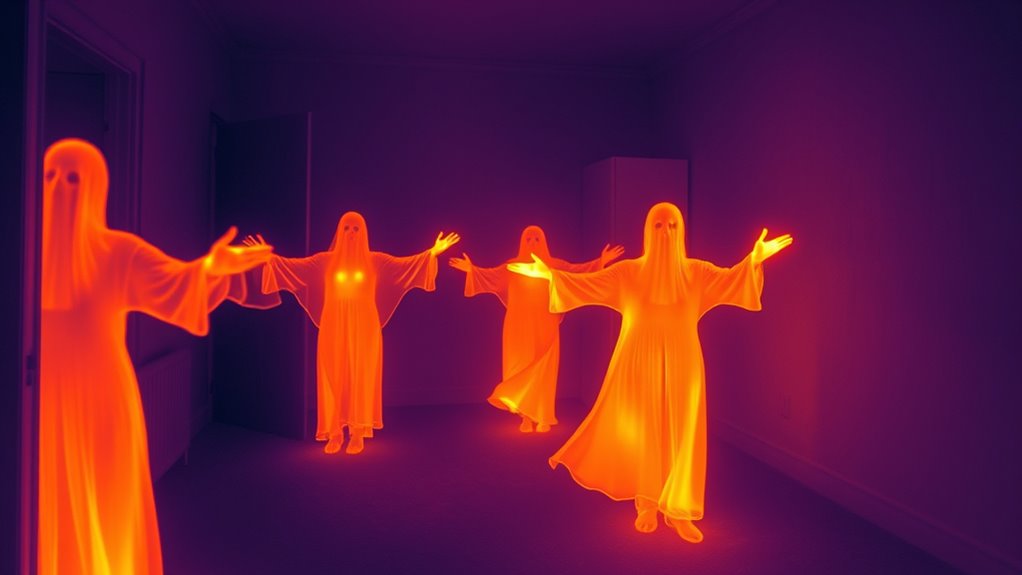
Advancements in thermal technology are poised to revolutionize paranormal research by enhancing detection capabilities and providing clearer insights into mysterious phenomena. Improved thermal sensor advancements offer higher sensitivity and faster response times, allowing you to detect subtle temperature changes more accurately. These sensors can distinguish between environmental factors and genuine anomalies, reducing false positives. Additionally, integrating augmented reality into thermal imaging devices can overlay temperature data directly onto your view of a location, making it easier to interpret heat signatures in real-time. This technology enables you to visualize paranormal activity more intuitively and share findings seamlessly. As these innovations develop, you’ll gain more precise tools to explore the unseen, opening new frontiers in understanding ghostly phenomena through cutting-edge thermal imaging.
Frequently Asked Questions
Can Thermal Imaging Definitively Prove the Existence of Spirits?
You can’t rely solely on thermal imaging to definitively prove spirits exist. Thermal anomalies might suggest unusual activity, but they can often result from equipment calibration issues or environmental factors. While thermal imaging helps detect temperature changes, it doesn’t provide concrete evidence of spirits. You need additional investigations and context to interpret these anomalies accurately, preventing false conclusions about paranormal presence.
How Do Environmental Factors Affect Thermal Readings During Investigations?
Environmental factors like ambient interference and temperature fluctuations markedly impact thermal readings during investigations. You need to be aware that nearby heat sources, drafts, or even changing weather can distort thermal images, making it harder to interpret potential ghostly heat signatures. By controlling or accounting for these factors, you increase the accuracy of your thermal imaging, helping you distinguish genuine anomalies from environmental noise.
Are There Specific Patterns Indicating Paranormal Activity in Heat Signatures?
When you look for patterns indicating paranormal activity, focus on cold spots and unexpected heat fluctuations. These anomalies may appear as sudden drops in temperature or irregular changes that don’t match environmental factors. Such patterns often suggest something unusual is happening, especially if they persist or appear without a clear explanation. Trust your thermal imaging to reveal these subtle signs, but always consider natural causes before jumping to conclusions about paranormal activity.
What Training Is Required to Accurately Interpret Thermal Images in Ghost Hunts?
They say “practice makes perfect,” and this holds true for interpreting thermal images in ghost hunts. You need specialized training to understand training requirements and improve your image interpretation skills. You should learn about thermal imaging technology, recognize normal versus abnormal heat signatures, and understand environmental influences. With proper training, you’ll develop a sharper eye for spotting potential paranormal activity, making your investigations more accurate and insightful.
How Cost-Effective Is Thermal Imaging Equipment for Amateur Investigators?
You might wonder if thermal imaging equipment is cost-effective for amateur investigators. It often offers a good cost comparison, especially considering its ability to detect subtle heat signatures. While initial investment can be high, many models are durable and built to last, making them a worthwhile purchase. If you’re serious about investigations, the benefits of thermal imaging can outweigh the costs, providing valuable evidence and enhancing your investigation skills.
Conclusion
As you explore thermal imaging for ghost hunting, remember that while it offers intriguing clues, it’s not foolproof—think of it as the ghostly equivalent of a crystal ball. Keep your equipment sharp and your mind open, but don’t forget to question every heat signature. With each investigation, you’re like a modern-day ghostbuster, blending tech with curiosity—almost as if you’ve stepped into a supernatural episode of The Twilight Zone.



